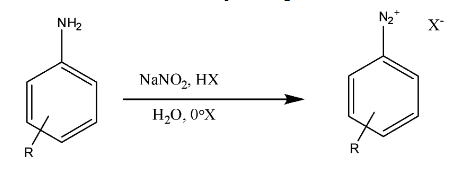
What is diazotization?
Answer
579.6k+ views
Hint:This reaction is based on the aromatic amines, when there is a reaction with the nitrous acid. From the name itself, we can say that the product obtained must be related to the diazonium salt.
Complete step by step solution:
> Let us define the diazotization. It is a chemical process involved in organic chemistry.
- It is the conversion of primary aromatic amine into the diazonium salt of amine by the use of nitrous acid; also known as diazotization.
- This reaction was discovered by Peter Griess, and he proposed many reactions having diazonium salts.
Now, we will see the reaction representing the diazotization is

> We can see that this reaction represents the reaction of primary aromatic amines with sodium nitrite, and a strong acid (HX); this is together named as nitrous acid.
> Thus, the unstable intermediates are formed from the diazotization of primary aromatic amines, and the counter ion present can be isolated.
> In the last, we can conclude that diazotization leads to the formation of diazonium salts.
> Additional information: The diazonium salts have been used in many applications such as in dye, and pigment industries; as standard reagents in the production of organic compounds; and most important in the field of nanotechnology.
Note: Don’t get confused about sodium nitrite, and a strong acid is named as nitrous acid. It is generated in situ form, and a strong acid can be hydrochloric acid, or sulphuric acid. Now, this can also create a confusion that how the counter ion can be isolated, it will be isolated only if it acts non-nucleophilic.
Complete step by step solution:
> Let us define the diazotization. It is a chemical process involved in organic chemistry.
- It is the conversion of primary aromatic amine into the diazonium salt of amine by the use of nitrous acid; also known as diazotization.
- This reaction was discovered by Peter Griess, and he proposed many reactions having diazonium salts.
Now, we will see the reaction representing the diazotization is

> We can see that this reaction represents the reaction of primary aromatic amines with sodium nitrite, and a strong acid (HX); this is together named as nitrous acid.
> Thus, the unstable intermediates are formed from the diazotization of primary aromatic amines, and the counter ion present can be isolated.
> In the last, we can conclude that diazotization leads to the formation of diazonium salts.
> Additional information: The diazonium salts have been used in many applications such as in dye, and pigment industries; as standard reagents in the production of organic compounds; and most important in the field of nanotechnology.
Note: Don’t get confused about sodium nitrite, and a strong acid is named as nitrous acid. It is generated in situ form, and a strong acid can be hydrochloric acid, or sulphuric acid. Now, this can also create a confusion that how the counter ion can be isolated, it will be isolated only if it acts non-nucleophilic.
Recently Updated Pages
Master Class 12 Business Studies: Engaging Questions & Answers for Success

Master Class 12 Economics: Engaging Questions & Answers for Success

Master Class 12 English: Engaging Questions & Answers for Success

Master Class 12 Maths: Engaging Questions & Answers for Success

Master Class 12 Social Science: Engaging Questions & Answers for Success

Master Class 12 Chemistry: Engaging Questions & Answers for Success

Trending doubts
What are the major means of transport Explain each class 12 social science CBSE

Which are the Top 10 Largest Countries of the World?

Draw a labelled sketch of the human eye class 12 physics CBSE

How much time does it take to bleed after eating p class 12 biology CBSE

Explain sex determination in humans with line diag class 12 biology CBSE

Differentiate between homogeneous and heterogeneous class 12 chemistry CBSE




